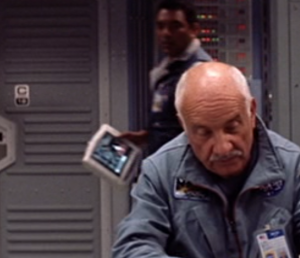(Note: If you haven’t read my Red Planet commentary, please do so before reading this one.)
Ahhhh, the vision of the future from 2000. Internal combustion engines are dead and the space program is alive. Mission to Mars, I just can’t quit you.
When we get our first glimpse of Mars in this film, we see a rover doing its best R2D2 impression as it drives through a canyon, camera darting about wildly as if scared. Either NASA has really improved its telemetry rates or the folks back home are getting treated to a jerky, blurry, frenetic view. Why would you program a rover to do that?
Then we see an astronaut on Mars, swinging the jeepers out of a rock hammer, narrowly missing his face shield on the upstroke each time. His hand better not slip!
Unlike the space station in Red Planet, Mission to Mars’s round module actually rotates! …And then we cut to an interior shot with people walking down a hallway that’s clearly not curved. That station must be HUGE to see no curvature. Thankfully the film does a much better job with the Mars-bound ship, in a beautiful scene that rips off pays homage to 2001, and also has a very nice transition from artificial gravity to weightlessness as an astronaut moves from the rotating module to its gravity-free center.
Oh. This is going to be one of those movies, is it? The face on Mars. I’m not even going to waste my time discussing the face on Mars stuff. NASA has a nice page debunking this one. Once you show the face on Mars, picking on the movie becomes like shooting fish in a barrel. Let’s rapid fire a few key points:
Their computer’s voice response system is very strange. Tim Robbins clearly states a command and nothing happens. Then the Sliders guy says the exact same thing and the computer does it. Is it keyed to Jerry’s voice or is Tim Robbins just a jerk?
Due to an anomaly (and an inexplicably massive explosion), the astronauts must abandon ship and seek refuge in a resupply module. In one of the best examples of how momentum doesn’t work, Tim Robbins sacrifices himself to save his crew and we learn that the computers on their spacesuits are capable of complex orbital/fuel usage calculations in realtime. They may have gotten one thing right here though. In an attempt to save Tim’s life, they use some sort of winch/grappling hook device. If you’ve ever watched astronauts performing a spacewalk, you may have seen them use power tools like electric screwdrivers. Newton’s 3rd law tell us that for every action, there’s an equal and opposite reaction. If an astronaut tried to use a regular electric screwdriver, Newton’s 3rd law would demand that the astronaut rotate in the opposite direction from the screw! That obviously doesn’t happen so what’s going on? Turns out NASA is pretty clever. They have constructed their power tools so that, for every rotating part (like a screwdriver) there is a counter-rotating part, a reaction wheel, so that we don’t try to break the laws of physics or require our astronauts to spin around in circles just to tighten a screw. In the winch/hook scene in Mission to Mars, it appears that the tool has a counter-rotating reaction wheel. Amazing that they’d care so much about one particular law of physics but completely ignore another.
Wow, iPads sure got bigger and clunkier in the future.
At least Red Planet just went and terraformed all of Mars. This film maintains a breathable atmosphere and comfortable temperature inside a greenhouse that’s skinned with, by the looks of it, a single layer of orange Hefty bags. If my attempts at office horticulture have taught me anything, it’s that plants struggle to survive in limited sunlight, and my poor plants only have to cope with a north-facing window! I think they’d be none too happy in a dark tent on Mars.
Another theme we’ll revisit: everyone in sci-fi films loves to take off their helmets at the first sign of oxygen. Astronauts are not this dumb! In this instance they have a wrist-mounted device that can determine atmospheric pressure and composition. Well, it is the future. Maybe mass spectrometers have gotten a lot smaller. Kinda makes you wonder what else is built into that iPad…
Ultimately we learn that intelligent life arose on Mars before Earth, but Mars was impacted by a huge meteor, leaving the planet uninhabitable, and the Martians were forced to flee. Before going, they left us the gift of DNA, which apparently was the key to starting the Cambrian explosion on Earth. Then the movie closes by ripping off paying homage to amniotic fluid scene in The Abyss and we’re all left wondering how this thing could be so much worse than a Val Kilmer flick.



